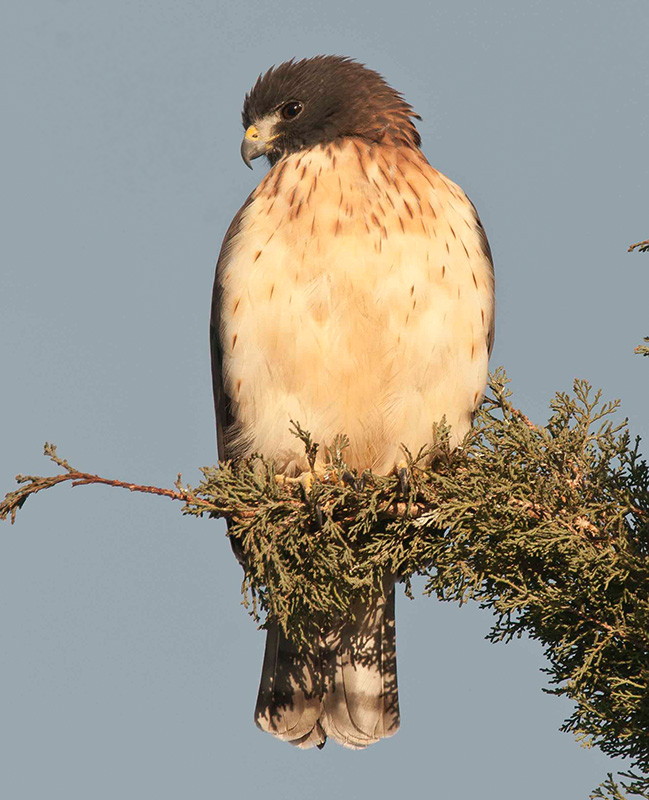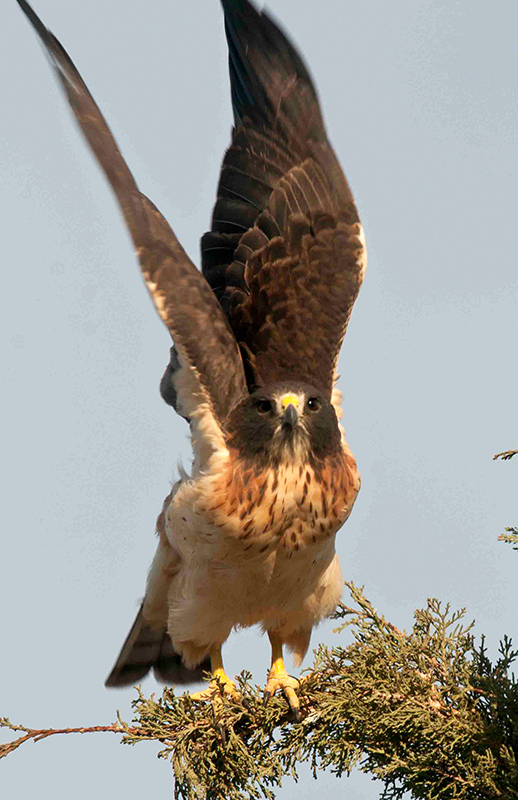 |
 |
|||||||||||||||||||||
|
||||||||||||||||||||||
Short-tailed Hawk (Buteo brachyurus), intersection of Hampton and Ridgeway in Tucson, Pima County
This Short-tailed Hawk
is presumably the same bird returning for its fourth winter in Tucson. It
was first reported this year by Jim Notestine on 28 October 2010. It was photographed by William Higgins on 20 December
2010
This species has recently expanded its range into SE Arizona and has bred in the Chiricahuas. It is accidental outside of the Sky Islands, but may be expanding northward.
The aberrant plumage of this bird has generated some controversy. It does not appear to be a typical adult light morph Short-tailed Hawk. Short-tailed Hawks normally have buffy underparts only in their first year and then are presumed to molt into the white underparts typical of adults. However, the sequence of plumages and molts in Short-tailed Hawk is poorly known (Miller and Meyer, 2002, Birds of North America, Online).
Two possibilities have been suggested for this bird:
1) Dave Stejskal has suggested it is an erythristic individual, not a normal light-morph adult. If anything, it's darker and more richly-colored than any of the three prior winters. Although it has not been documented in Short-tailed Hawks, erythrochroism (excessive red pigment) is well documented in other buteos that exhibit light and dark morphs (such as Red-tailed Hawk, Ferrruginous Hawk and Swainson's Hawk). , William Clark, well known raptor expert and author of raptor field guides, has examined these photos and supports the conclusion that this is a heavily pigmented adult Short-tailed Hawk.
2) Others have suggested it might be a hybrid, possibly with Swainson's Hawk. Adult Swainson's Hawks are buffy underneath so such a parentage could explain the retained buffy color of this bird. In Arizona, Short-tailed Hawk and Swainson's Hawk nest in different habitats, but rare birds can do strange things to find a mate and an attempted hybrid pairing was reported in Texas in 2005. Falconers have also created some crazy hybrids in captivity, but there is no evidence this is an escaped falconer's bird. Chris Benesh notes that his dorsal photo of the bird shows some other characters that are atypical for Short-tailed Hawk and perhaps more typical of Swainson's: rather prominent rusty edgings to the scapular feathers, rusty fringing to the feathers of the upper back and nape and noticeably grayer-edged inter-scapular feathering. None of these features is typical of adult Short-tailed Hawk. But perhaps these are simply part of some abnormal pigment expression. Finally, the streaking on the breast is to some extent, a ghosting of the bib pattern found on Swainson's and the darker mesial stripe (running down the center of the throat) is a feature often found on Swainson's Hawks. Overall, the bird shows many more characters of Short-tailed Hawk and few characters of Swainson's Hawk. It should be noted, however, that even first generation hybrids are not necessary 50/50 phenotype mixes of their parents and one parental phenotype can strongly dominate the other.
Without extensive examination of birds of known parentage, it is generally
very difficult to infer a bird's genetic makeup (genotype) from its appearance
(phenotype). It may therefore be very difficult to resolve this issue
without a DNA analysis.


20 December 2010, photo by William Higgins
23 December 2010, photos by Dave Stejskal

21 December 2010, photo by Chris Benesh
All photos are copyrighted© by photographerSubmitted on 20 December 2010
|
©2005
|
HOME | | | REPORT SIGHTINGS | | | PHOTOS | | | BIRDING | | | JOURNAL | | | ABOUT US | | | CHECKLISTS | | | AZ BIRD COMMITTEE | | | EVENTS | | | LINKS |